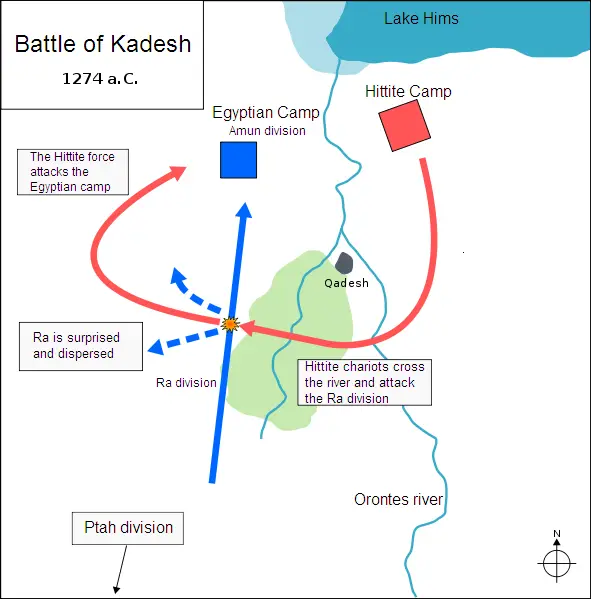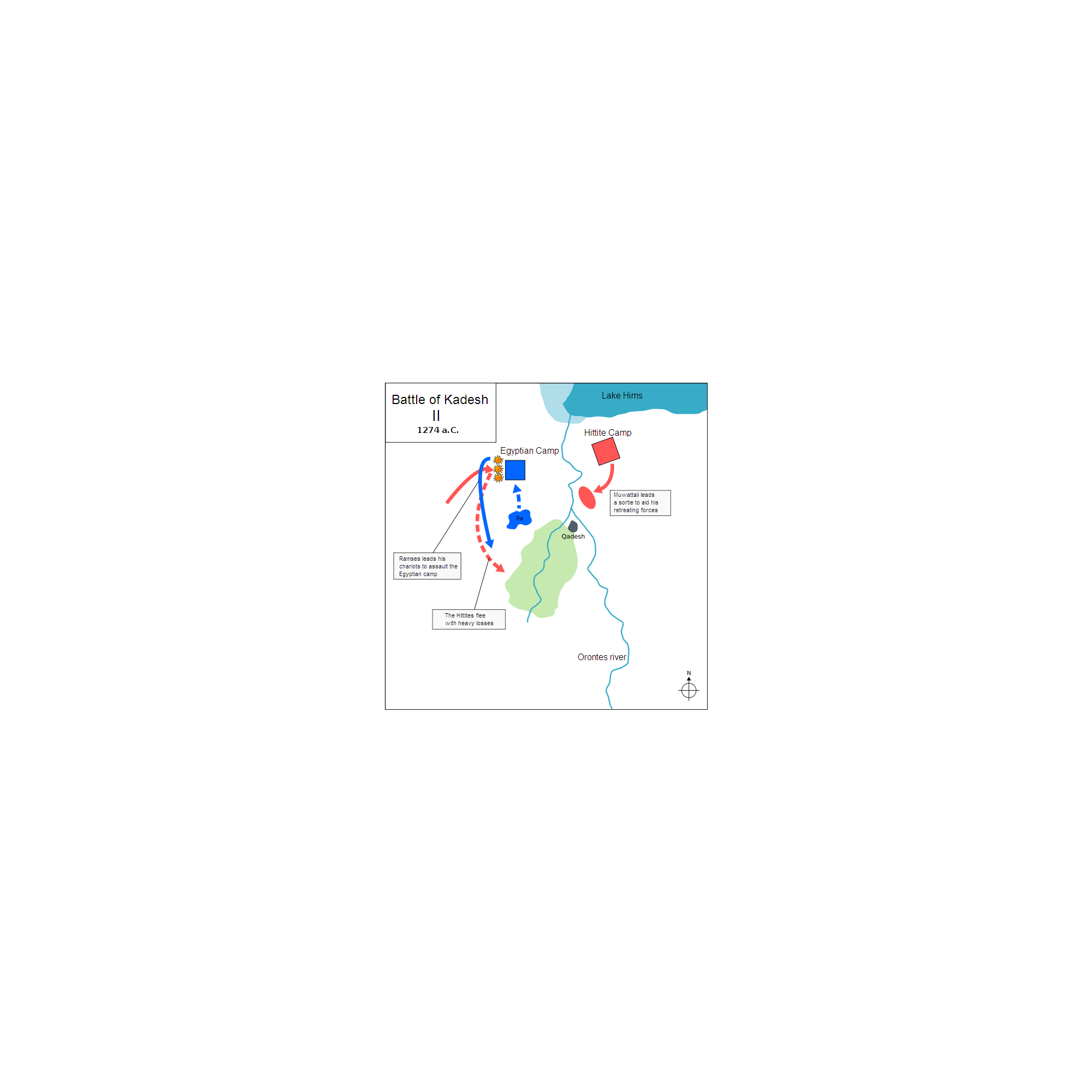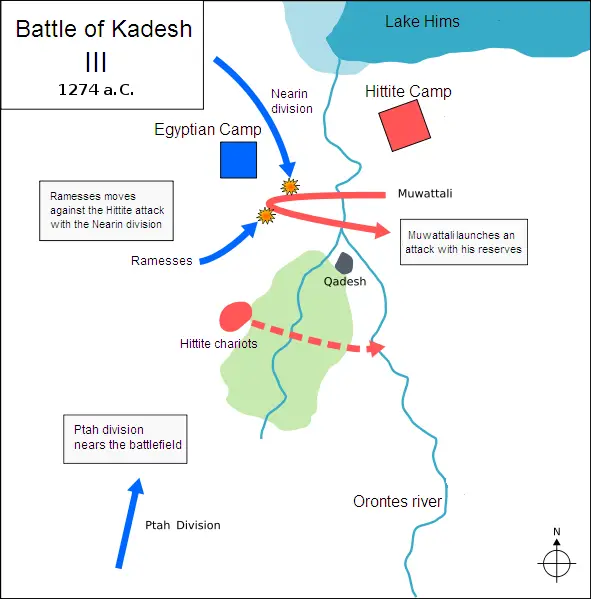The Battle of Kadesh
The Battle of Kadesh was one of the most well-known battles in the Middle East in ancient times, pitting the famous pharaoh Ramses II and a strong Egyptian force against an even stronger Hittite army. Both sides wanted to control the city of Kadesh and the area around it; what happened as a result of the clash of the two armies depends on the source. 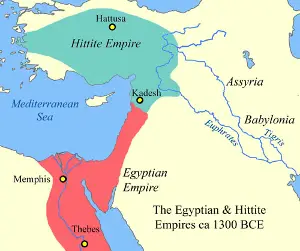
Kadesh was a strategic settlement on the Orontes River in what is now Syria but in ancient times was in a land called the Levant. A variety of Middle Eastern civilizations controlled Kadesh at various times, among them the Hittites and the Mittani. As Egyptian pharaohs flexed their military muscles in the area, they came into conflict more and more with the Canaanites, Hitties, Mittani, and others. One of the first known pharaohs to force the issue against the Mittani was Thutmose I, who ruled in and around the beginning of the 14th Century B.C. A few decades later, a large Egyptian force under Thutmose III defeated an alliance of forces from Canaan, Kadesh, and Mittani at the epochal Battle of Megiddo. After this success, the armies of this and a handful of later pharaohs fanned out into the area, driving the borders of the empire to its greatest extent. Egypt assumed control of Kadesh at this point and held it for a time. The Hittites later took control and held it for the reign of several pharaohs, including Akhenaten, Tutankhamen, and Horemheb. Seti I in 1306 B.C. briefly conquered Kadesh but lost it again to the Hittite king Mursilis II not long afterward. Ramses II took the throne in 1279 B.C. and set about planning to expand the borders again. Five years later, he set his sights on Kadesh. He assembled a large army at his new capital, Pi-Ramses, and set out for what he anticipated would be a smashing victory.
Ramses stood in his chariot at the head of his army, which numbered about 20,000. Cashing in on some of the military secrets left behind by the Hyksos, Ramses also had at his disposal a few thousand war chariots, filled with warriors wielding large bronze scimitars and powerful armor-piercing composite bows. The pharaoh had a high opinion of himself and of his people, and he felt confident that they would emerge victorious. As the Egyptians neared Kadesh, they captured a handful of nomads who at the time were living in the area. Under pressure, the captured people said that the Hittite army of King Muwatalli II was away at the moment and that an Egyptian conquest of Kadesh was assured. Wanting to take full advantage of the absence of the Hittites, Ramses and two of his four divisions raced ahead, outpacing the rest of the army. Ramses was at the head of a small group of men, which included his bodyguard, as he arrived north of the city of Kadesh, where we was joined soon afterward by one of his four divisions, the Amun. The other three were named Ptah, Ra, and Set. Ramses chose to wait for the Ra division to arrive; during this time, his army captured two Hittite scouts, who revealed the truth: that the nomads were actually Hittite spies who had not given the truth of the situation, which was that Muwatalli and his army were hidden just outside the city. Estimates are that the Hittite force was about 50,000. Springing into action, the Hittites crossed the Orontes River south of the city and confronted the Ra, aiming to keep them from reaching Ramses and the Amun division. With surprise on their side, the Hittite routed the Ra; very few of the Egyptians made it through to join up with their pharaoh. Then, Muwatalli turned north to confront Ramses. The Egyptians gave ground, but a fierce counterattack The Hittites cut their losses and left the battlefield, regrouping far enough away to avoid being a target. The Egyptians, having also lost a large number of men, were in no position to take the city. Further, they were exhausted and out of supplies and were in no position to maintain a siege of the city. Ramses led his army back to Egypt, where he declared victory. A significant number of Egyptian contemporary sources tell of the Egyptian victory at Kadesh. It is true that the Hittites were the first to leave the field of battle; however, they did not lose control of the city. Hittite sources of the time tell a different story, of how they still held the city once the fighting was done. |
|
Social Studies for Kids
copyright 2002–2025
David White



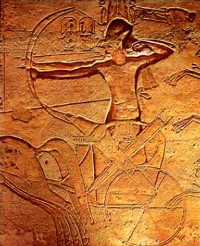
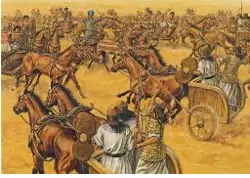 led by Ramses himself forced the Hittites back to the east. This counterattack was so successful that the Egyptians left their camp undefended, and the Hittites, unable to help themselves, set about looting. Egyptian reinforcements arrived, and it looked briefly like Ramses and men were going to carry the day. Muwatalli still had superior numbers, however, and sent his chariot reserves into the fray. Six times, Hittite chariots charged the Egyptian lines; six times, the Egyptian line held. The arrival of the Egyptian Ptah division gave Ramses greater strength, and Muwatalli abandoned the idea of any further charges. He had had a strong force of infantry at his disposal but had not deployed it.
led by Ramses himself forced the Hittites back to the east. This counterattack was so successful that the Egyptians left their camp undefended, and the Hittites, unable to help themselves, set about looting. Egyptian reinforcements arrived, and it looked briefly like Ramses and men were going to carry the day. Muwatalli still had superior numbers, however, and sent his chariot reserves into the fray. Six times, Hittite chariots charged the Egyptian lines; six times, the Egyptian line held. The arrival of the Egyptian Ptah division gave Ramses greater strength, and Muwatalli abandoned the idea of any further charges. He had had a strong force of infantry at his disposal but had not deployed it.